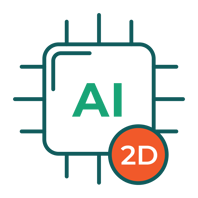Fault picking is inherent in the role of a geoscientist; however, it doesn’t need to be a cumbersome part of the role when building a complex interpretation.
Brought together with Geoteric’s industry-leading workflow, AI Faults - 2D Networks has been designed in step with traditional interpretation techniques. Essentially moving the interpreter away from the monotonous and into control, interacting with the automated faults enables new ways of working both experts and students can check, manage and trust.




Prioritising AI-driven cutting edge features such as Geoteric Adaptive Faults, AI Faults - 2D Networks has the potential to save months in the project whilst limiting those repetitive fault picking tasks.
Interpreters can improve the network's knowledge of the given data set's fault characteristics to create a bespoke network for more accurate results.
A stepping stone in the right direction
We understand new technologies come with some level of trepidation. Many organisations have found AI Faults - 2D Networks provides a great introduction to the use of AI in seismic interpretation as it is more closely aligned with your traditional way of working.

Customisable to fit your workflow

Unbiased data-driven results
with the ability to fine-tune

Seamless integration with
existing workflow
How is AI Faults - 2D Networks different to Geoteric Stratum™ AI Faults - 3D Networks?
AI Faults - 2D Networks detects faults in a 2D manner. It processes the data volume as a composition of 2D slices, characterising faults, much like traditional working methods. The output is then combined to produce a 3D AI fault volume.
Accuracy is greatest within Geoteric Stratum™ AI Faults - 3D Networks which detects faults in a 3D manner. However, it is important to note that there is a significant uplift in AI Faults - 2D Networks results from traditional interpretation methods. The choice of solution depends on a range of factors including field complexity, data quality, ambition, time and budget.
Can I fine-tune the results?
Yes. Fine-tuning allows you to focus on features that you, the interpreter, see as the critical elements in the data set to elevate results further.
Adding a series of data labels, fault sticks provide the network with further information specific to the volume it is analysing. This allows the network to remove previously detected faults and/or identify faults that were initially unidentified.
How many faults do we have to interpret? Is this across many inlines and crosslines?
Select the lines which feature characteristic examples of the faults you would like to fine-tune. We’ve found four to six lines is usually enough to start with. The algorithm then analyses labelled samples and the latest information is added into a new network.
Can I share my network with team members?
Yes. Fine-tuned networks can be shared with another AI Faults - 2D Networks user and/or project team.
Can I make more than one fine-tuned network?
Yes. We understand bespoke networks can be an iterative process as results are determined or categorised accordingly. You can assess the results of the latest fine-tuning round and decide whether further work is needed.
If further training is required, an already fine-tuned network can be trained again using the existing fault sticks, and/or new fault sticks can be added.
How much user training is involved?
Wherever you are on your AI journey, Geoteric’s AI Faults - 2D Networks is simple for beginners and powerful for experts who use Geoteric today.
Training can be a costly resource, but it doesn’t have to be. Although by design Collaborative AI is comprehensive and vast, you don’t need to be a data scientist to use it. We’ve found our 90-minute webinar training package, covers the low training threshold required for adoption. By design, the session equips users with the knowledge they need to get up to speed with first use and integrate this technology with ease into their existing workflow.
Do you have a maximum volume size I can load? Are there any limitations?
The latest version of Geoteric AI Faults - 2D Networks has been tested on volumes up to 350GB.
The only large volume limitation is the size of RAM on your machine. Each inline and crossline must be held in memory to be processed. We recommend your inline or crossline does not exceed 12GB in size as this is likely to be the maximum your machine can process. However, this is dependent on the resources and hardware of your device, and we would recommend speaking to your IT support to confirm this.

Whether you’re looking to enhance your traditional workflow or focus your accuracy, you can explore the capabilities of our AI seismic interpretation software by booking a free demo.